
|

|
Per i lettori italiani: in questi tempi moderni siamo abituati a oggetti tecnologici che rimangono in produzione a malapena per una stagione: basta pensare alle fotocamere digitali, in cui ogni pochi mesi l'intero assortimento è rinnovato. E naturalmente ogni nuovo modello "scaccia" il predecessore.
Ma una 3021, una 4052 o un 5106 erano a catalogo prima che nascessi e lo sono stati fino all'altroieri... Per quanti anni?
Proprio per rispondere a questa domanda, ho provato a far passare i cataloghi, dal 1950 ad oggi, individuando gli articoli più rappresentativi... un lavoro di pazienza, che però è stato ricco di fascino e di sorprese.
La "longevità a catalogo" diventa un'interessante chiave di lettura, una preziosa peculiarità della produzione Märklin classica. E soprattutto qualcosa di irripetibile: ormai anche la stessa produzione Märklin si misura nel volgere di pochi anni, certo non dei decenni!
Chi ha vinto, dunque? I segnali ad ala 7039 e simili, insieme alla minuscola illuminazione 7077 si classificano al primo posto con 54 anni. E sono ancora a catalogo nel 2006!
Seguono la linea aerea e la gru 7051 (53 anni, entrambe fuori catalogo), il carro tramoggia 4610 e l'immortale locomotiva 3000. Le carrozze da 24 cm arrivano a 45 anni, così come il binario M a punti di contatto. Infine tra 30 e 40 anni l'elenco si affolla: 3078, 3095, 3021, 4040 e altri ancora...
Naturalmente si potrebbe sottilizzare sulle varianti o i miglioramenti tecnologici: ho scelto di usare una certa elasticità e di privilegiare la riproduzione dello stesso rotabile vero e la sostanziale costanza della tecnologia. Ad esempio il lamierino è lamierino, anche se magari i finestrini sono migliorati o hanno aggiunto l'arredamento, mentre il passaggio da terza rotaia a punti di contatto rappresenta un salto tecnologico non trascurabile, così come l'introduzione del comando digitale. Infine guardo alla costanza del numero di articolo, fatta salva naturalmente la rinumerazione del 1957.
Poi ci sarebbero da far passare le singole tecnologie, anch'esse di grande interesse: per esempio il classico relé per l'inversione, nella sua forma più tipica (20824) che ancora nel 1994 era in dotazione a circa 22 locomotive, ma che oggi dovrebbe essere ormai scomparso; oppure i due motori tradizionali, quello con collettore a disco (spazzole 60030) e il suo progressivo sostituto a collettore cilindrico (spazzole 60146).
Ma questo ve lo racconterò un'altra volta...
Modern objects remain in stock only for very short periods, but if we look at classic Märklin production, we find a completely different situation. A 3021, a 4052 or a 5106 have been introduced many years before I was born, and remained in stock until few years ago. How long did they last?
In order to answer to such a question, I spent some time looking at old catalogues, from 1950 to the present days, and I found many interesting things.
The "longevity" of Märklin models becomes an interesting way to investigate the world of model railroads. Furthermore, it is something that will never occur again: it is easy to imagine that even Märklin production, nowadays, is going to change quickly, as any other industrial item.
So, who won? The semaphores of the 7039 family, together with the small lighting kit 7077 gain the first position, with a longevity of 54 years. And they are still in stock in 2006!
Then we find the slewing crane 7051 and the classic catenary (53 years each), the ballast car 4610 and the well-known loco 3000. 24-cm express coaches reach 45 years, as well as the M-Track with contact points. Finally, many items are between 30 and 40 years: 3078, 3095, 3021, 4040 and many others...
In the analysis, I consider that the model is not changed when it reproduces the same real vehicle and it uses the same technology. So a sheet metal coach is considered the same article even if it has minor changes, such as interior fittings or different windows (plastic frame instead of cellon), but the introduction of contact points instead of third rail makes the M-Track a new one, as the technology is really improved. Also the Delta/Digital control is considered a strong change, while the mechanical/electronic reverse unit (33xx locos in 1982) is considered a minor change (although very effective in performances). The change in numbering occurred in 1957 is simply shown for the corresponding articles.
Another interesting field would be the analysis of each single technology, such as the classic mechanical reverse unit (20824) or the type of motor (disk versus cylindrical collector). But this will be the subject for a future article...
Finally I would like to thank the Spanish Lista de Correo de Trenes Märklin, whose PDF catalogues available at lctmweb.dyndns.org/Biblioteca/Catalogos/index.htm saved me a lot of time in scanning images.
| |
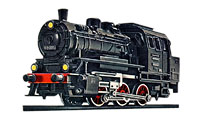 | 3000, BR 89 (former: CM 800) 1953 - 2002 = 50 years In 1953, this was the first Märklin loco with plastic body (together with CE 800 = E.63), and soon became one of the symbols of Märklin production, as it was included in most of starter sets for half a century. Changes in details reflect the history of Märklin locos. In 1959 it had front light diffuser instead of two bulbs, in 1963 the hand lever for manual reversing was removed, in 1996 cylindrical collector replaced traditional disk collector. By 1963 1 million locos were produced, and over 5 millions by 2000. In 2002 it was replaced by 30000 with Delta control and (probably) different motorization. |
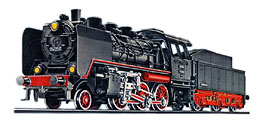 | 3003, BR 24 1956 - 2002 = 47 years Another famous steam engine, with plastic body: an intermediate level (also in price) between 3000 and larger locomotives. When it was discontinued, it was not replaced by a new and more detailed model (although a Delta model 30033, with same body but probably a different motorization, was delivered in 2003-2005). |
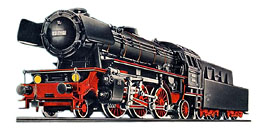 | 3005, BR 23 (former: DA 800) 1954 - 1972 = 19 years A famous steam engine of the mid 1950's generation with metal body: although very detailed and impressive for those years, it became "out of date" in less than two decades and disappeared in early 1970's. 1969-70 as 3097. |
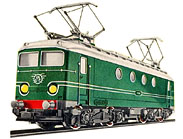 | 3012, Loco SNCF old style (former: SEW 800) 1951 - 1968 = 18 years The early 1950's generation included engines without an exact correspondence with a real loco. Among these, the 3012 was the last one to be discontinued: it disappeared as late as 1969. Similar articles: 3013 blue |
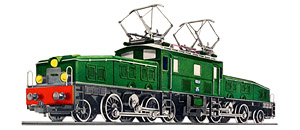 | 3015, SBB Be 6/8 (former: CCS 800) 1947 - 1975 = 29 years The symbol of Märklin: the Swiss Crocodile in its first H0 version. Its longevity is not so high, no more than the half of the top-lasting models, but when it was discontinued in 1975, no other engines of the Forties were still surviving. The worm-screw drive with a special motor was a unique case in Märklin production, in which the standard motor with cylindrical-tooth gears was used almost everywhere. Metal body. Worm-screw transmission. |
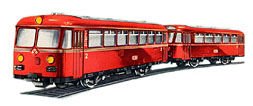 | 3016, Schienenbus VT 95 (former: DB 800 K) 1955 - 1997 = 43 years A simple railcar, with plastic body and not particularly detailed, surprisingly survived for over 40 years. In 2006 a new model of the Schienenbus appeared with metal body and, of course, digital control. Similar articles: 4018 trailer |
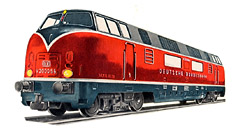 | 3021, V200 1957 - 1989 = 33 years The main new item for 1957 was the famous V200 (later BR 220) with metal body. In 1984-88 also the beige/oceanblue livery was produced (3081), but few years later the original model was replaced by another one, completely rebuilt (still with metal body), first as BR 221 and then also as BR 220. |
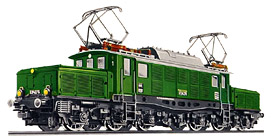 | 3022, BR 194 1964 - 1997 = 34 years What V200 is among diesel engines, E.94 is among electric locos: no surprise if this well-known series was the main new item in 1964. In 1982 this was one of the first models, that received the new reverse unit with electronic circuit. Although the base model is discontinued, similar models with the same body and digital control were delivered recently (e.g. 39223 in 2003). Since 1982 as 3322 (mechanical/electronic reverse unit). |
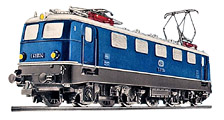 | 3034, BR 141 1960 - 1979 = 20 years Among the famous and widespread family of classic DB E-locos, Märklin introduced the first E 41 (later BR 141) in 1960, with a metal body and a very precise reproduction, at least for those years. Some new versions were introduced during 1990's and early 2000's, especially for the entry level Hobby line (e.g. 3034 oceanblue and 3037 red). Similar articles: 3037 N60 |
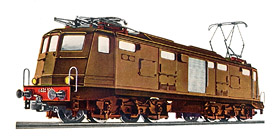 | 3035, FS E.424 1960 - 1985 = 26 years For Italian modellers, this is the Märklin loco: the only Italian engine of the traditional production. It can be considered a milestone not only for the AC system: in the Sixties, Italian locos from other firms were out of scale or too much toy-oriented, while the 3035 was a good, full-metal, exact scale model. More than 25 years later, it followed the evolution of the real engine, with the new version for commuting trains, with different livery and some details updated. In recent years (2001-2005), further commuting versions appeared, also with final XMPR livery, but their Delta or digital control make them too different from the original, to be listed here. 1988-91 in red/grey livery (E.424.2) as 3162. |
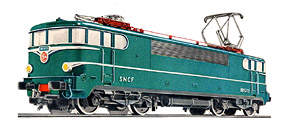 | 3038, SNCF BB 9200 1963 - 1988 = 26 years This French model has a story similar to Italian E.424: designed in the Sixties with metal body and updated with a new livery in the Eighties. After it was discontinued, other French models were introduced, both modern and historical (as the famous BB 12000), but no new BB 9200 has been designed. Since 1982 in Corail livery as 3165. |
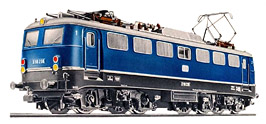 | 3039, BR 110 blue 1965 - 1991 = 27 years Five years after the 3034/3037, the similar engine BR 110 was introduced, with improved details (windows, roof, lettering, ...) and a proportionally higher price. The 1965 catalogue explicitly compared the two models. Just like the 3034, also the 3039 had various new models in 1990's (e.g. 3344, 3440). Similar articles: 3040 green |
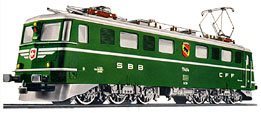 | 3050, SBB Ae 6/6 1964 - 1986 = 23 years One of the most famous Swiss engines was introduced in mid Sixties with a massive metal body. In this case the replacement model, presented in 1991, is still full-metal (but with many improved details): after the "plastic era" of 1970-80's, around 1990 Märklin turned back to die-cast bodies, at least for high-end models like the Ae 6/6. Since 1985 as 3350 (mechanical/electronic reverse unit). |
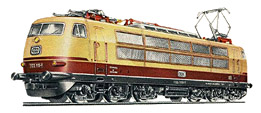 | 3054, BR 103 1971 - 1994 = 24 years The first version of E.03 (later BR 103) was presented in 1966, and reproduced the pre-series engines, with a single row of grids on the body. In 1971, the version corresponding to the final BR 103 appeared. It had plastic body but the metal frame was extending also to the lower (red) part of the body. Together with 3022, the 3054 received the first reverse unit with electronic circuit in 1982. Many new versions appeared along 1990's, especially in Era V red livery. Finally in 2003 the BR 103 was completely reworked with full metal body and brushless C-Sinus motor. Since 1982 as 3354 (mechanical/electronic reverse unit), since 1983: 3357 (single-arm pantograph). Similar articles: 3053 pre-series N66-70 |
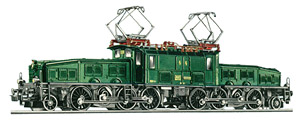 | 3056, SBB Be 6/8 1976 - 1987 = 12 years In 1976 the old metal Crocodile was no more "up to date": Märklin presented a new model in exact scale and with many details but, surprisingly, with plastic body. Actually 1970's can be considered the "plastic era", when competition towards other firms lead Märklin to a cost-saving policy and plastic construction was a necessary choice. Nevertheless 3056 was a good model, representing a true improvement with respect to the old 3015 of 29 years before. Later, Märklin turned back towards a high-end market where full metal construction was required, and in 1990 a new Crocodile in exact scale but again with a metal body was delivered. Plastic body. Since 1982 as 3356 (mechanical/electronic reverse unit). |
 | 3060, F7 Santa Fe 1961 - 1997 = 37 years Only one engine was produced for the US market, although it was possibly the most famous: the great F7 diesel loco, available in the Santa Fe version, with metal body. In recent years, Märklin delivered various other US engines, both steam and diesel. Similar articles: 4060 dummy |
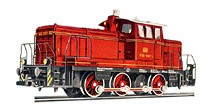 | 3065, BR 260 Telex 1963 - 1991 = 29 years The V60 (later BR 260) shunting loco was an ideal model for appreciating the qualities of the Telex coupling, i.e. the device capable of uncoupling wagons in every point of the layout. By means of a more complex reverse unit, the 24 V impulse from the transformer, normally used for reversing the direction, could also power a small solenoid that caused uncoupling. Apart from this, the loco was quite simple, with plastic body. Of course, in the Digital era, uncoupling can be operated digitally, and a complex mechanical reverse unit is not needed anymore... Similar articles: 3064 N63 |
 | 3071, SBB/NS TEE RAm 1965 - 1985 = 21 years The main new item for 1965 was one of the four diesel railcars used for Trans Europ Express services: the 4-car Swiss-Dutch RAm train (the German train VT 11.5 appeared from Märklin only 37 years later, in 2002, while the Italian ALn 442/448 was produced in the Sixties by Rivarossi and the French railcar was delivered by Roco around 1990). The RAm had plastic body and was shortened in length (some windows are missing). In recent years the RAm was reissued, with some improvements (e.g. interior fittings): for the last time in 2002 with C-Sinus brushless motor, anyway with the same body. Up to 1970 as 3070 (interior lighting). Similar articles: 4071 intermediate coach |
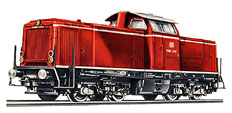 | 3072, BR 212 red 1966 - 1997 = 32 years In late Sixties, some widespread DB diesel engines were produced according to the typical technique of those years: plastic body on a pressure-cast frame. BR 212 was among them. During the Eighties, this model also received the blue/ivory livery; in recent years new versions have been produced: for example the Digital 37725 in 2003. |
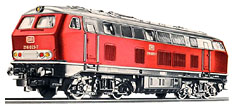 | 3075, BR 216 red 1968 - 1991 = 24 years Two years after the BR 212, also the famous BR 216 appeared, with the same structure and a similar history: blue/ivory in the Eighties, new version 3375 in 1990's (electronic reverse unit) and other Delta/digital versions in recent years. In early 1970's the BR 216 also replaced previous V 200 in one of the classic starter sets, together with D-Zug coaches. |
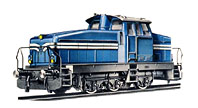 | 3078, DHG 500 blue 1967 - 2005 = 39 years A small works locomotive was introduced four years after the V 60: the absence of rods could keep the price lower. The body is made of plastic, upon a pressure-cast frame. |
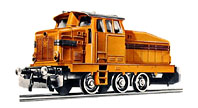 | 3080, DHG 500 yellow 1967 - 1988 = 22 years The yellow 3080 is a simplified version of 3078, without reproduction of handrail and axle boxes and with no headlamps. This made the 3080 one of the cheapest engines in Märklin range, together with steam 3087. In 1991, 3088 introduced a new, more modern body (with a "squared" shape) on the same frame. |
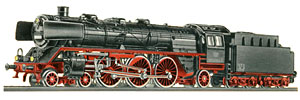 | 3085, BR 003 1973 - 2002 = 30 years When it was introduced, the real BR 003 was still running (although for few years only), and the model was intended to be a high-end reproduction of one of the most famous DB steam engines for fast trains. It replaced previous steam locos of the 1950's generation (like 3048 = BR 01 and 3005 = BR 23) and was built with a "mixed" technique: metal boiler and plastic cab. The gears were concealed: a feature not usual for Märklin engines in those years. In the last years, when more detailed engines of the 01 family were produced, 3085 was included in the Hobby line and this let it survive for exactly 30 years. |
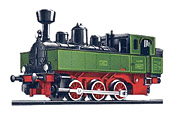 | 3087, Green steam engine 1972 - 2005 = 34 years Märklin always produced a cheap steam engine, not exactly based on a real DB loco, that was included in the simplest starter set and had to be even cheaper than the classic 3000, used in the sets a bit more expensive. In 1972 the 3087 replaced the previous 3029 (with plastic body just like 3087 but with smaller water boxes). In 1980 another simple steam engine was introduced (3104) and also used for starter sets, but the 3087 survived for 25 years more. In 2006 the 3087 was re-issued in digital version (36871), but it used a new China-made compact motor that deprived it of all the fascination of a "true" Märklin model. Similar articles: 3090 black N72 |
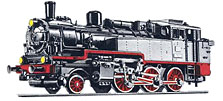 | 3095, BR 74 1968 - 2002 = 35 years The BR 74 can be considered the tank version of BR 24: it was produced in 1968 with cheap plastic body and had a quite long life, until it was replaced by a Delta version (30951, 2003-2006). |
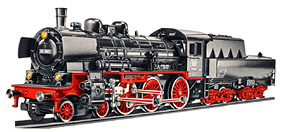 | 3099, P8 1967 - 2002 = 36 years The P8 is one of the most famous Prussian locos. The 3098 model was quite simple (especially in the wheelset area), but with a full metal construction. In 1978 the new version 3099 turned from DB to DR (Era II), thus changing fairings and tender. Around 1990 it turned back to Era III, without changing article number. In 2003 a new, digital, highly detailed, full metal version of P8 was introduced (also in the Italian version Gr. 675). Up to 1977 as 3098, Era III. |
| |
 | 4000, Platform Coach 1957 - 1980 = 24 years The simplest passenger coach in Märklin range, built with the "usual" sheet metal technology. Windows are simply cut, without cellon. |
 | 4040, Platform Coach 1960 - 1991 = 32 years A bit more detailed version of 4000, surviving a decade more, after being used for almost every passenger train contained in a starter set. |
 | 4107, Platform Coach 1971 - 2006 = 36 years This very simple, entry-level, 2-axe plastic coach, designed in 1970 to replace sheet metal models such as 4000, shows an extraordinary longevity, that lead it to the present days. Up to 1980: 4007 green; since 1994: again also with green livery as 4039 Similar articles: 4108 |
 | 4147, Z DB (Eurofima) 1980 - 1994 = 15 years Starting from 1980, the new 26.4 m coaches were designed with a length of 26.4 cm, instead of 27, in order to meet an "exact" 1:100 scale. The Eurofima model was offered also in the livery of many other countries (almost all, except FS!). |
| |
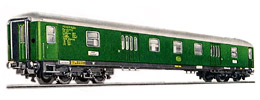 | 4026, Express Baggage Car 1958 - 1997 = 40 years In 1958 Märklin introduced the first coaches of a new series, reproducing the standard 26.4 m express coaches (Type X of UIC, also known as D-Zug-Wagen). They were designed with a shorter length, with respect to the exact scale length of 30.3 cm. Nevertheless, the modern and linear shape of the real coaches well suited the sheet metal technology, and these models soon became one of the best products in Märklin range, so that previous sheet metal coaches were discontinued after few years. A substantial improvement was the introduction, between 1964 and 1965, of the new windows with plastic frame, that replaced the original cellon sheet (in which the window frame was cut together with the coach body). A complete description of all sheet metal and 24 cm long coaches is contained in a detailed article. Up to 1963: cellon windows. Similar articles: 4023 and 4024: N58 |
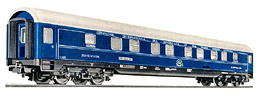 | 4029, WL CIWL, blue 1960 - 1983 = 24 years The same structure of the standard express coaches was used also for many other passenger coaches, including this sleeping car. |
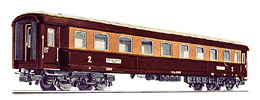 | 4036, Bz 33.010 castano-Isabella 1960 - 1971 = 12 years For those countries which had not introduced the standard 26.4 m coaches, specific models were designed: this is the case of the Italian FS coach, which reproduces the Bz 33.000 series (although with less windows). |
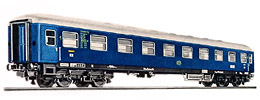 | 4051, Express Coach, 1st cl. blue 1959 - 2002 = 44 years The 1st and 2nd class express coaches are the most representative models of the sheet metal technology and appeared in the liveries for three eras (blue/green of Era III-IV, oceanblue/beige of Era IV and blue/white of Era V). After few years, around 1970, most of 24 cm coaches received plastic interior fittings: this was the last important improvement, after which these coaches were produced for about 30 years without further changes. The last items appeared in 1996-1997 as new modern liveries of existing models. The whole production was discontinued in 2003, thus closing an era in Märklin history. Up to 1964: cellon windows. Up to 1971 as 4027. |
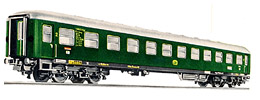 | 4052, Express Coach, 2st cl. green 1958 - 2002 = 45 years Up to 1963: cellon windows. Up to 1971 as 4022. |
 | 4054, Restaurant, red POP livery 1972 - 1990 = 19 years The POP livery was not introduced for 24 cm coaches (except for a late production in 1997), but only the restaurant received this livery, and maintained it for a quite long period. |
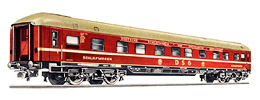 | 4064, Sleeping car DSG, red 1967 - 1993 = 27 years |
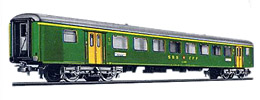 | 4066, SBB, EW II 1st cl. green 1968 - 1994 = 27 years The standard coaches of Type II of Swiss railways are quite different from 26.4 m coaches, but the Märklin model 4066 uses the same "style" also for this vehicle. |
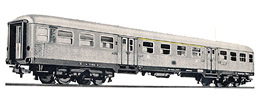 | 4083, Silberlinge 12cl. 1963 - 1980 = 18 years The Silberlinge family is another typical example among the 24 cm coaches. All coaches were replaced by the new plastic models introduced in 1982, variations of which are still in stock. First years as 4043. Up to 1964: cellon windows. |
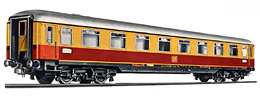 | 4085, TEE compartment coach 1966 - 2002 = 37 years When they appeared, the TEE coaches were intended to be at the top of Märklin models: for example, they were among the first to receive interior fittings in 1968. In 1974 the lettering was changed into UIC-numbers (of course most of 24 cm coaches were born with Era III lettering). Although the 27-cm TEE coaches appeared as soon as 1974, the basic models of 24-cm TEE remained in stock for 28 years more, until the end of the sheet metal era. Up to 1967 as 4055, without interior fittings. Similar articles: 4087, 4090 |
 | 4111, Express coach 1st cl. beige/oceanblue 1976 - 2002 = 27 years When this very beautiful new livery was introduced on DB, also the sheet metal coaches were repainted, and survived in this livery, together with the more modern 27-cm version (see below), up to 2002. Similar articles: 4112 |
| |
 | 4091, Express coach 1st cl. beige/oceanblue 1972 - 1989 = 18 years In early 1970's, plastic technology appeared to be more "modern" and realistic than traditional sheet metal. Märklin carried out a renewal plan that included express coaches. The length was again a compromise, between old 24 cm and true-to-scale 30.3 cm. The first production batch had a metal frame for bogies, then a full-plastic bogie was introduced, thus changing the interior lighting from 7324 to 7325 (later 7329). In 1972-74 the POP livery was used, then it was turned into the oceanblue/beige livery, without changing the article number. Around 1992, most of 27-cm coaches were reworked to fit the new short coupling mechanism. Some of them are still in stock today with various liveries. In 2006 a new series of express coaches was introduced, with a bit higher length (28.2 cm) and more details. This new series will probably replace 27-cm versions, about 35 years after its first models. 1972-74: POP livery (same article number) Similar articles: 4092 |
 | 4095, TEE compartment coach 1974 - 1989 = 16 years Also the TEE coaches were redesigned with plastic body (except the bar unit, which existed only in sheet metal version). |
 | 4150, TEN DB 1976 - 1989 = 14 years The 27 cm standard was used for all 26.4 m vehicles, thus including sleeping cars. |
Go to Page 2 with freight cars and accessories.
Vai alla seconda pagina con i carri merci e gli accessori.
Tutti i dati come tabella in  formato Excel / All data as Excel table.
formato Excel / All data as Excel table.
The Excel file also contains a sheet for Z scale models.